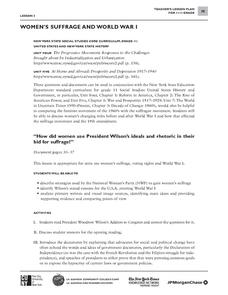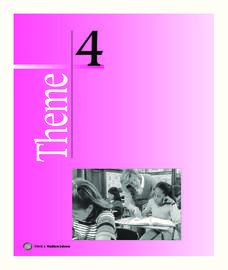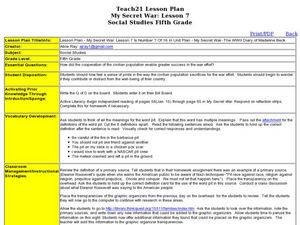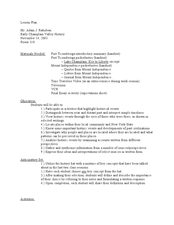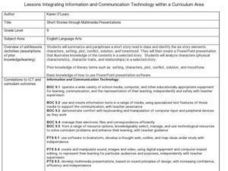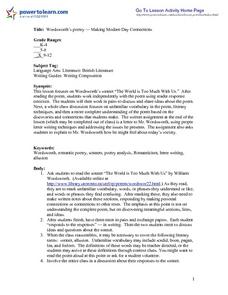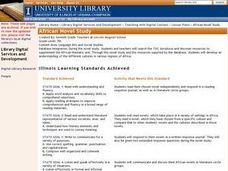Project Maths
The Unit Circle
It's not just any circle—it's the unit circle. The fourth instructional activity in the series is an introduction to the famous unit circle. While working through a series of activities, young scholars learn the components of the unit...
Scholastic
Voyage on the Mayflower for Grades 6–8
Imagine living in the hold of a sailing ship for 63 days, enduring rough seas and autumn storms. As part of a study of the voyage of the Mayflower, class members examine an online resource that details life about the ship, watch a slide...
City University of New York
Woman's Suffrage and World War I
How did women use President Wilson's ideals and rhetoric in their bid for suffrage? To answer this essential question, class groups analyze primary written documents and visual images.
Houghton Mifflin Harcourt
Problem Solvers: English Language Development Lessons (Theme 4)
How can you teach a text to a group of readers who struggling with the language? The second in a set of three ESL lessons related to Theme 4: Problem Solvers engages English language learners by introducing vocabulary and grammar...
National Science Teachers Association
Hop into Action
Young scientists find out what makes amphibians such unique and interesting animals in this simple life science instructional activity. After looking at pictures and discussing the characteristics of amphibians, learners...
Curated OER
Susan's Choice
Young economists explore opportunity cost by counting how much money Susan has in her piggy bank. From here, they are challenged to help Susan make a choice about what she can buy with her money.
Curated OER
"Julie of the Wolves"
Fifth graders research life in Alaska and compare life there to their lives in this lesson plan. They read "Julie of the Wolves." They research through the novel and other reference books facts about the Alaskan climate and geography. ...
Curated OER
"The Adventure of the Blue Carbuncle"
Seventh graders read Sherlock Holmes silently and work together to demonstrate an understanding of the story. They participate in small group and whole class discussions and analyze Holmes' method of deducing details about an object and...
Curated OER
Historical Fiction: A Wealth of Interpretations
Students read a book from the Dear America series and contrast different points of view. They respond to the book either by participating in a literature circle or completing a journal entry. They compare and contrast two books or a...
Curated OER
It's Raining Meatballs
Students observe and demonstrate the process of summarization using the book "Cloudy With a Chance of Meatballs" by Judi Barrett. They silently read the story, and as a class discuss the five W's. Students then write a short summary of...
Curated OER
Second Graders Create Their Own Social Studies Book (Part I, The 5Ws of the Constitution)
Students develop their own social studies textbook using a blank theme book as they complete activities and learning experiences throughout the year. The activities are in art, music, simulations, read alouds, shared writing and a class...
Curated OER
When Sophie Gets Angry-Really, Really Angry
Students explore feelings. In this language arts lesson, students realize that books help in talking about feelings. Students discuss how they feel during the reading of a story and listen to each other in answering various comprehension...
Curated OER
My Secret War: Lesson 7
Fifth graders discuss the cooperation of the civilian population during World War II. In this social studies lesson, 5th graders read My Secret War and complete reflection strips over the reading. Students discuss primary sources.
Curated OER
Early Champlain Valley History
Class members use primary sources to craft an essay about early Champlain Valley History. I would use this as a homework assignment.
EngageNY
Grade 5 Math Module 1, Topic B, Lesson 6
Which is bigger? The sixth installment in an 18-part series covering decimals provides a lesson on comparing decimals to the thousandths. Teachers use place value to help class members compare and order decimals. Instruction encourages...
Curated OER
Independent - To Be or Not Top Be - Day 2, Lesson D: Intestinal Fortitude
Fifth graders explore intestinal fortitude in terms of their oral presentation.
Curated OER
Reading And Responding: Lesson 15 Nonfiction
Eighth graders examine a nonfiction selection in a teacher led lesson plan. They examine the author's purpose for writing the selection and identify the difference between fact and opinion. The compare and contrast expository and...
Curated OER
Waterfalls
Third graders practice identifying the main idea and supporting details when reading informational text. They read text related to waterfalls and practice note taking skills to identify critical details. Students use their notes to...
Curated OER
Finding Self-Reliance
Fourth graders relate what is read to their own experiences and feelings and use active listening to respond to other students' comments. After a lecture/demo, 4th graders utilize an Active Listening Chart imbedded in this plan to gain...
Curated OER
Short Stories Through Multimedia Presentations
Ninth graders summarize and paraphrase a short story read in class. They identify the six story elements of character, setting, plot, conflict, solution, and tone/mood. Students create a PowePoint presentation that illustrates the...
Curated OER
Wordsworth's Poetry
High schoolers read Wordsworth sonnet, "The World is Too Much With Us," and complete reader response criticsm worksheets. They examine the poet's ideas and techniques then write a letter to Mr. Wordsworth and explain how he might feel...
Curated OER
African Novel Study
Seventh graders participate in literature circles as they read African novels. They read, work on word studies, and complete comprehension activities. They share their reading with other literature circle groups in the class.
Curated OER
The Cuban Revolution
In this Cuban history learning exercise, learners respond to 8 short answer questions about the Cuban Revolution and the American response to the conflict.
Curated OER
That Was Then - Persuasive Essay
Student explain how geographic and cultural settings influence a person's identity. They compare and contrasting Esmeralda Santiago's Puerto Rican self with her American self by participating in a close reading of the text and writing a...


